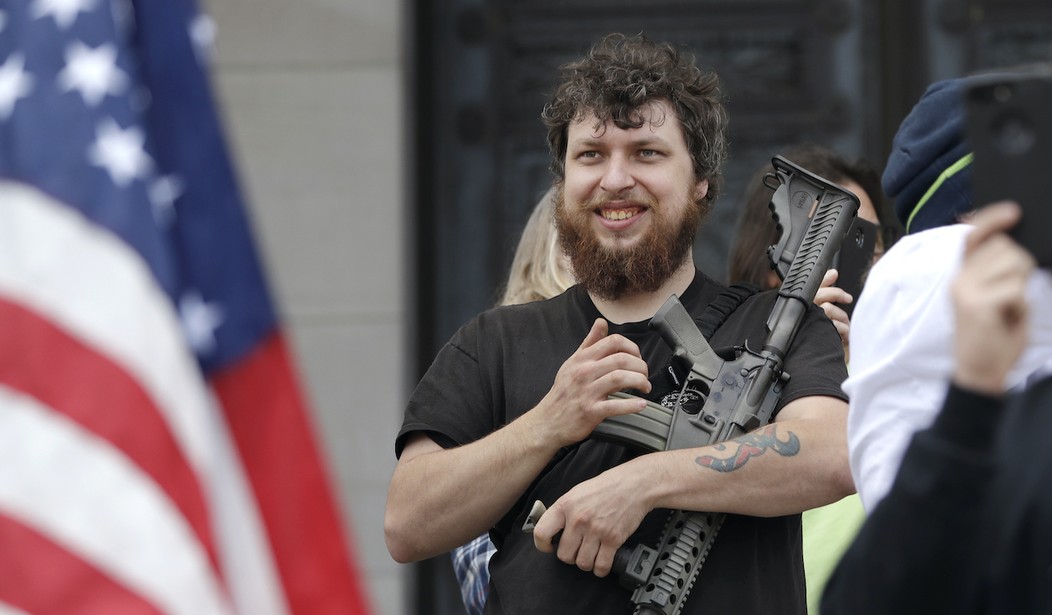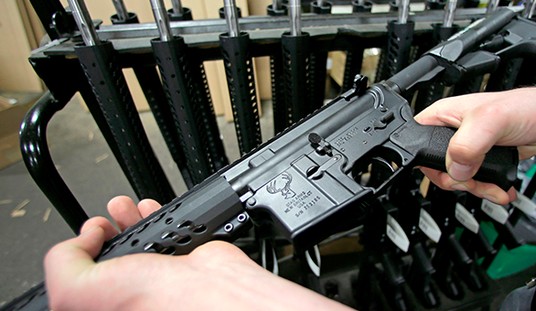It’s not uncommon to see armed Americans at the growing number of protests and rallies in favor of re-opening the economy, but one thing I’ve noticed is that some of them don’t seem to be practicing social distancing measures like staying six feet away from people or wearing a mask in large crowds. I find that to be very odd, given that most of us own firearms for self-defense. At this particular moment in time, Americans are more likely to die from the coronavirus than homicide. If you own a gun to protect yourself from people, why wouldn’t you wear a mask to protect yourself against a virus that’s killing more of us than we’re killing each other?
As of Wednesday, there have been more than 47,000 deaths attributed to the coronavirus in the United States since early February (the first coronavirus deaths were believed to have been in Washington State in early March, but two recent autopsies from the San Francisco area showed the deaths in early February were caused by COVID-19). I know there’s a lot of debate about the veracity of the total death numbers, but let’s say that as many one in two of these deaths have been misidentified as coronavirus-related. Now we’re looking at 23,500 deaths in the U.S. from the virus in less than three months. That’s still far more than the 16,214 homicides reported by the FBI in all of 2018 (the last year for which statistics are available).
In fact, while we haven’t reached this milestone yet, at some point in the next few weeks we will have more confirmed cases of the coronavirus than all reported violent crimes in 2018. We’re at about 843,000 confirmed cases of coronavirus, and for the past few days we seem to be seeing a plateau of about 25,000 new cases reported each day. In 2018, there were 1,245,000 violent crimes in the United States, from aggravated assaults to rape, robbery, and murder. Based on current trends, we’ll have more coronavirus cases than violent crimes about three weeks from now.
The coronavirus is deadlier and more common than violent crime in the United States, so why not throw on a mask along with your handgun when heading out to protest to show you take your personal safety seriously, whether from violent crime or a deadly virus? Make no mistake, I believe that Americans have a fundamental right to protest and peaceably assemble, just as they have the fundamental right to keep and bear arms. Note also that the title of this piece says “you should also wear a mask”, not “you should be made to wear a mask.” I believe this is a matter best addressed through individual responsibility and some positive peer pressure, not law enforcement or governmental edicts.
I’m not opposed to these rallies, but from both a messaging and personal safety standpoint, it makes sense to have as many attendees as possible practicing safe protesting. There was a protest in Israel against Benjamin Netanyahu the other day, and the images were captivating, regardless of the message. If hundreds of protestors were on the grounds of a state capitol doing this, the media would eat it up.
Of course, they’d still find a reason to dismiss the message, but the image of hundreds of Americans taking both their health and their civil liberties seriously would be striking.
The purpose of a protest isn’t just to gain attention, however. It’s about making a difference, and organizers and attendees (as well as their supporters who are staying at home) need to understand that the majority of Americans are okay with staying home, at least for now, according to a new Reuters/Ipsos poll.
The poll, released Tuesday, suggested that only a minority of Americans agree with the recent flare-up of protests against social-distancing initiatives. Their numbers have been growing over the past few weeks, however, mostly among Republicans.
Overall, in the national online poll from April 15-21, 72% of adults in the United States said people should stay at home ‘until the doctors and public health officials say it is safe.’ That included 88% of Democrats, 55% of Republicans, and seven in 10 independents.
It also found that 45% of Republicans said stay-at-home orders should be lifted to get the economy going again, up from 24% of Republicans who said the same thing in a similar poll that ran March 30-31.
Republicans are coming on board with the idea of lifting stay-at-home orders, but even on the right there’s still majority opposition to the idea. Democrats are likely viewing the debate as a pro-Trump/anti-Trump argument and we’re not likely to see much movement from them until party leaders signal it’s okay to do so, but when 70% of independents aren’t on your side, calling them sheep and cowards unafraid to stand up to tyranny isn’t going to convince many of them that they’re wrong.
If the organizers of these protests aren’t just grifters looking to make a quick buck, attention-seekers looking to advance their brand, or both, then they absolutely should care about how to be most effective in persuading people to their side. One way to do that is to demonstrate that the people who are advocating for the re-opening of businesses are responsible individuals, and that opening the economy doesn’t translate to being irresponsible. We had a small protest here in Virginia last week, and organizers were talking about hugging fellow protestors and sharing food. Was it attention-grabbing? Sure. Was it dumb? Yes. When you rely on stunts to get attention, that’s what gets attention. Any larger message is going to be lost by the media fixating on something of no real consequence, and if you’re going to attend a rally or protest, beware of organizers more interested in selling the sizzle than the steak.
The protest in Israel I mentioned above is a perfect example of how to sell the sizzle and the steak. The media couldn’t resist the images, and as a result the protestors message was able to be disseminated across the globe. Personally, I think that’s much more effective than sharing some potato salad with a stranger.
So if you’re going to a protest, armed or not, why not throw on a mask and stand six feet away from others? Not because The Man is telling you to, but because you want to win, and in order to do that people have to take you and your message seriously. You’re not protesting for retweets or shares on Facebook. You’re protesting because you’re worried that you won’t be able to pay your mortgage next month, or because you would rather spend your day at work than stand in line for food at a food bank.
You’re there because you’re angry that your governor isn’t opening up the economy or has put idiotic restrictions on individual liberty in place, but if we’re being honest you’re probably there because you’re scared. In fact, if you allow yourself to think about it, you could become absolutely terrified at what the future might hold if our nation were to sink into a prolonged depression because of the coronavirus. And you know what? It’s okay to be scared. It’s reasonable to be scared. These are scary times. Just don’t tweet about how you cried yourself to sleep the other night like Brian Stelter did.
I happen to think that most Americans (even the 88% of Democrats and 70% of independents who say we should stay at home until The Experts tell us it’s okay to come out) share those fears, and that’s where protestors can find common ground and a point of persuasion with some of those who disagree about when to open up the economy. That’s ultimately what the argument is about; timing. No one is seriously arguing we can or should keep the nation’s economic engine idled forever. It’s all about when will it be safe to do so. If the re-open movement can both personalize stories of how the stalled economy is already impacting them, and demonstrate that they’re as serious about their personal safety as they are their individual liberties, they could make a difference in more than just red states.









